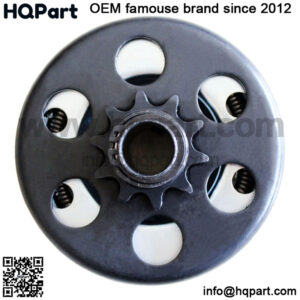Clutch problems on your go-kart can be an annoying and cumbersome experience. Most of the time the go-kart clutch needs to be carefully inspected, in order to diagnose the problem to determine the underlying issue.
The most common go-kart clutch problems are:
- Overheating Clutch
- Stuck Clutch
- Clutch Not Engaging
- Clutch Engages Early
Whether you are experiencing an overheating clutch, a clutch that is stuck, not engaging or engaging too early, you’ll need to identify the issue before you can proceed to fix it.
Below is an illustration of the internal components of a go-kart clutch. You’ll need to familiarize yourself with them so that you’ll know which parts need to be fixed.
Go-Kart Clutch Description
- Tension Spring
- Friction Material
- Flyweight/Shoe
- Pivots
A go-kart clutch that is not running optimally can reduce performance and cause premature wear. Follow the guide below on how to fix a clutch on a go-kart.
1. Overheating Go-Kart Clutch
An overheating clutch on a go-kart needs to be immediately assessed and fixed. If your clutch starts to overheat, you’ll notice a burning smell that is similar to burnt rubber.
Your clutch may be overheating due to several reasons. One of the most common reasons is a lack of lubrication. If your clutch is not lubricated properly, there is no agent that helps to reduce friction and disseminate heat.
As you’ll only want friction between the friction material and the drum of the clutch, the hub and areas below the brass bushing require a good amount of lubrication.
If these parts are frictious, excessive heat will be generated and over time will cause damage to the go-kart clutch.
How to Fix It:
You’ll need to lubricate your go-kart clutch with an oil or any other suitable lubricant. When lubricating your clutch, ensure to only apply it around the brass bushing (you’ll need to remove the snap ring or c-clip first).
Never lubricate the ventilation holes, as you do not want to lubricate the internal friction materials and the drum.
Here is a complete guide on how to oil your go-kart clutch. You should follow these steps carefully.
2. Stuck Go-Kart Clutch
A go-kart clutch that overheats over a prolonged period of time or that is exposed to excessive wear can have its internal components stuck together.
When a go-kart clutch is overheating on a regular basis and doesn’t get the required lubrication, heat can transfer from the external components to the internal components.
When this happens, the internal temperature gets so hot, that the metal components melt and stick together. The parts that are commonly affected by this are the friction materials such as the flyweight/shoe, the clutch drum and even the tension springs or the pivots.
How to Fix It:
The first thing you’ll need to do is assess the condition of your go-kart clutch. Remove it from the crankshaft of the engine. Be careful when removing it, as you will need to let it cool off first.
Open up the clutch by removing the drum and inspect the inner components. Use your hands to move each of the flyweights outward, inspect the tension springs and the pivots.
You’ll notice that some parts may be stuck together, due to excessive heat. A lack of heat dissipation can cause metal components to melt or deform. When this happens, it can restrict the flyweights to fully extend and will not allow the friction material to make contact with the drum.
In this case, remove the individual damaged or deformed components and replace them with new ones. If several parts are damaged, it’s recommended to install a new go-kart clutch.
3. Go-Kart Clutch Not Engaging
A go-kart clutch fully engages at about 1,800 rpm. Once that point is reached, the flyweights and the friction material make contact with the clutch drum through centrifugal force.
Therefore, it’s important that your clutch fully engages for it to be running optimally. If your clutch isn’t engaging properly, you’ll experience a delayed or jerky start after stepping on the accelerator.
There could be a few reasons why this could be happening. Most of the time, it’s due to worn out friction material of the flyweights/shoes, which need to be replaced.
Occasionally, it can also occur if the clutch was incorrectly lubricated and some of the oil entered into the clutch drum, which will lead to a lack of friction between the flyweights and the drum.
On rare occasions, the tension screws could be too tight, not enabling the flyweights to make contact with the drum at the diresed rpm range. Here is a quick summary of potential problems:
- Worn out friction material
- Lubricating the wrong areas
- Tension springs are too tight
How to Fix It:
If you’re dealing with worn out friction material you’ll need to either replace the flyweights or the entire clutch. Wear is common for go-kart clutches and these parts need to be maintained regularly.
Incorrect lubrication of internal components would require you to disassemble the entire centrifugal clutch and remove the lubricant. You should never lubricate the friction material, flyweights or the drum.
If the tension springs are too tight, simply replace them with standard springs.
4. Go-Kart Clutch Engages Early
A go-kart clutch may also engage too early. In some cases, you’ll notice the go-kart taking off once it’s been started. There could be several reasons for this and you’ll need to inspect the engine and clutch carefully.
One common reason for a clutch that instantly engages is when the idle speed of your go-kart engine is set too high. This is actually not directly related to the clutch but rather the idle speed of the engine.
Secondly, you could also be dealing with a clutch that is stuck. This means that the flyweights are constantly engaged, regardless of the engine’s rpm.
Lastly, you could be dealing with tension springs that are too loose. This could happen through excessive wear over time and will cause the flyweights to engage prematurely, as there is not enough tension in the springs.
Here’s a quick summary of the potential issues for a go-kart clutch that engages early:
- Engine idle speed set too high
- Tension springs are too loose
- Clutch components are stuck
How to Fix It:
If the engine idle speed is set too high, you’ll need to configure the engine. You can do this by adjusting the engine idle screw. You’ll be able to find more information on how to do this in the owner’s manual.
As tension screws can lose tension over time, you’ll need to check once you notice that your clutch is engaging too early. You can simply replace the worn or loose tension springs and reinstall the go-kart clutch.
As your go-kart clutch can instantly engage if the flyweights are stuck to the drum, you’ll either need to replace the damaged flyweights or the entire clutch depending on the overall condition.

